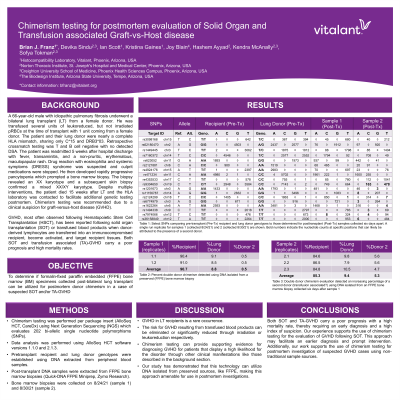Back

(P220) Chimerism testing for postmortem evaluation of Solid Organ and Transfusion associated Graft-vs-Host disease
Location: Platinum Ballroom

Poster Presenter(s)
Body: A 66-year-old male with idiopathic pulmonary fibrosis underwent a bilateral lung transplant (LT) from a female donor. He was transfused several units of leukoreduced, but not irradiated pRBCs at the time of transplant with 1 unit coming from a female donor. Retrospective crossmatch testing was T and B cell negative with no detected DSA. He was readmitted 5 weeks after hospital discharge with fever, transaminitis, and a non-pruritic, erythematous, maculopapular rash. Drug reaction with eosinophilia and systemic symptoms (DRESS) syndrome was suspected and culprit medications were stopped. He then developed rapidly progressive pancytopenia which prompted a bone marrow biopsy. The biopsy revealed an XX karyotype and a subsequent skin biopsy confirmed a mixed XX/XY karyotype. Despite multiple interventions, the patient died 15 weeks after LT and the HLA laboratory was contacted to facilitate additional genetic testing postmortem, due to a clinical suspicion for graft-versus-host disease (GVHD). GVHD, typically observed following hematopoietic stem cell transplantation (HSCT), has also been described following solid organ transplantation [SOT-GVHD] and blood transfusion (transfusion associated [TA-GVHD]) when passenger donor lymphocytes target recipient tissues. Double donor chimerism testing was performed by Next Generation Sequencing using pretransplant samples collected from the recipient and lung donor as well as DNA isolated from paraffin embedded bone marrow biopsies collected post-transplant. Postmortem donor chimerism testing detected an average of 90.7% recipient, 8.8% lung donor, and 0.5% second donor (presumably pRBC donor) and 85.3% recipient, 9.4% lung donor, and 5.3% pRBC donor for a secondary bone marrow biopsy sample collected 6 days after the first.
Conclusion: Both SOT and TA-GVHD carry a poor prognosis with a high mortality rate, thereby requiring an early diagnosis and a high index of suspicion. Our experience supports the use of chimerism testing for the evaluation of GVHD in SOT. This approach may facilitate an earlier diagnosis and prompt intervention.
Conclusion: Both SOT and TA-GVHD carry a poor prognosis with a high mortality rate, thereby requiring an early diagnosis and a high index of suspicion. Our experience supports the use of chimerism testing for the evaluation of GVHD in SOT. This approach may facilitate an earlier diagnosis and prompt intervention.

